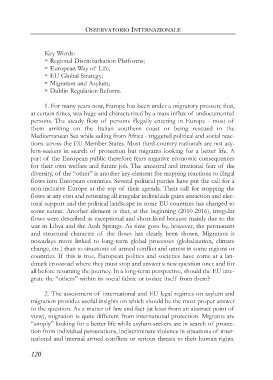Page 122 - Rassegna 2020-1
P. 122
OSSERVATORIO INTERNAZIONALE
Key Words:
➣ Regional Disembarkation Platforms;
➣ European Way of Life;
➣ EU Global Strategy;
➣ Migration and Asylum;
➣ Dublin Regulation Reform.
1. For many years now, Europe has been under a migratory pressure that,
at certain times, was huge and characterized by a mass influx of undocumented
persons. The steady flow of persons illegally entering in Europe - most of
them arriving on the Italian southern coast or being rescued in the
Mediterranean Sea while sailing from Africa - triggered political and social reac-
tions across the EU Member States. Most third-country nationals are not asy-
lum-seekers in search of protection but migrants looking for a better life. A
part of the European public therefore fears negative economic consequences
for their own welfare and future job. The ancestral and irrational fear of the
diversity, of the “other” is another key-element for mapping reactions to illegal
flows into European countries. Several political parties have put the call for a
non-inclusive Europe at the top of their agenda. Their call for stopping the
flows at any cost and returning all irregular individuals gains attraction and elec-
toral support and the political landscape in some EU countries has changed to
some extent. Another element is that, at the beginning (2010-2016), irregular
flows were described as exceptional and short-lived because mainly due to the
war in Libya and the Arab Springs. As time goes by, however, the permanent
and structural character of the flows has clearly been shown. Migration is
nowadays more linked to long-term global processes (globalization, climate
change, etc.) than to situations of armed conflict and unrest in some regions or
countries. If this is true, European politics and societies have come at a lan-
dmark crossroad where they must stop and answer a new question once and for
all before resuming the journey. In a long-term perspective, should the EU inte-
grate the “others” within its social fabric or isolate itself from them?
2. The assessment of international and EU legal regimes on asylum and
migration provides useful insights on which should be the most proper answer
to the question. As a matter of law and fact (at least from an abstract point of
view), migration is quite different from international protection. Migrants are
“simply” looking for a better life while asylum-seekers are in search of protec-
tion from individual persecutions, indiscriminate violence in situations of inter-
national and internal armed conflicts or serious threats to their human rights.
120

